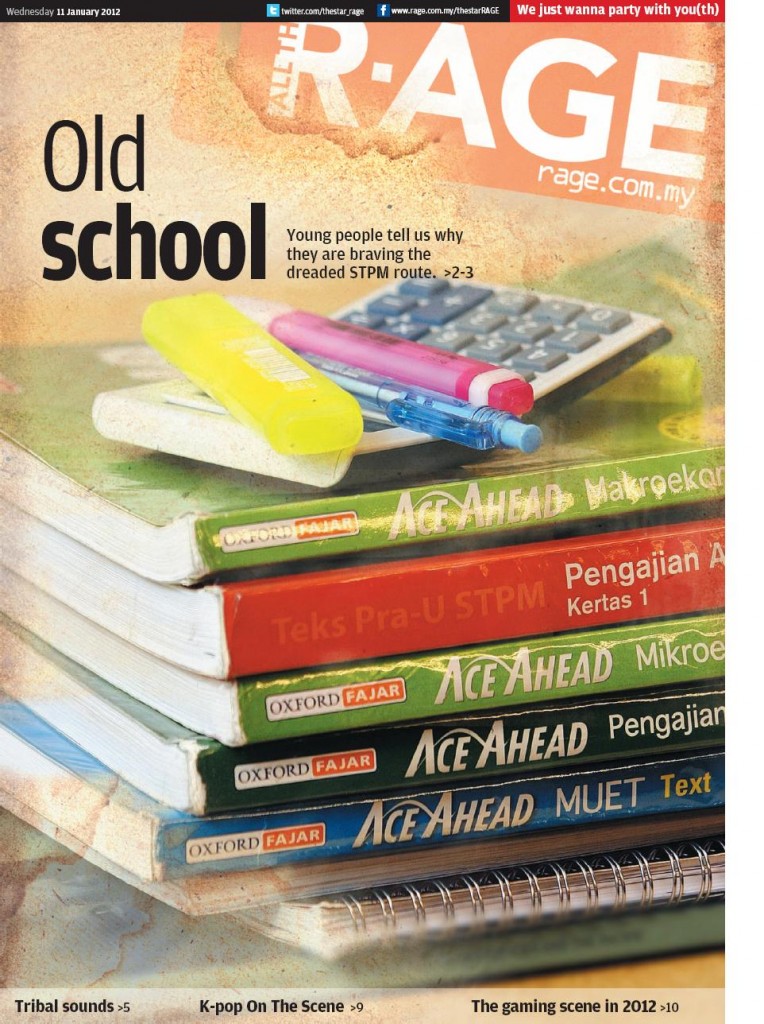By NASA MARIA ENTABAN
alltherage@thestar.com.my
THERE were only 10 people in Jasmine Abdullah’s sixth form class at SMK Taman SEA in Petaling Jaya, Selangor – everyone else had left to pursue their studies elsewhere.
There was a time when taking the Sijil Tinggi Pelajaran Malaysia (STPM) examinations was the only way to get into local universities, but these days there are so many options available with the mushrooming of private colleges.
Formerly known as the Higher School Certificate, STPM is one of the two major pre-university systems for admission to public universities (the other is a one-year matriculation programme, with limited allocations for non-bumiputeras).
While the STPM is internationally recognised by many universities (especially those within the Commonwealth of Nations as well as the United States and the Republic of Ireland) as a GCE A-Level equivalent, it isn’t exactly everyone’s first choice, even though – in comparison to college fees – taking the STPM costs almost nothing.
Few students brave this route because of STPM’s reputation as a tough examination to ace.
In 2010, out of the 50,576 candidates who sat for it, only eight scored straight As in all the five subjects they took.
Among students who sat for four papers, 297 achieved straight As.
Less than half of them, or 46.4%, obtained a full pass in all the papers they sat for.
It’s no wonder then that most students give STPM a pass, for it’s an especially tough obstacle course.
Furthermore, the option of taking the more “glamorous” route – going to college would seem a lot more appealing to a young adult who has already been through 11 years of “school life” – seems like a better choice.
While their peers are living on their college or university’s campus instead of under their parents’ roofs, choosing their lecture schedules themselves and wearing whatever they like to class, one wonders what would possess a sixth former to struggle through a year and a half’s worth of non-stop revision and slogging for elusive straight As (while donned in the unattractive blue-and-white uniform).
Then again, some people are made of sterner stuff and are not so easily daunted by hardships.
Or maybe they have no choice.
Affordable education
While school leavers from affluent families have more options when it comes to life after secondary school, their less affluent peers opt for the STPM because it makes economic sense.
“I knew my family could not afford to send me to college,” says 19-year-old Andrian Tam, who sat for his STPM examination last year.
“Matriculation and pre-university programmes in private colleges cost tens of thousands of ringgit, and going to form six was a lot more affordable than that.
“The sixth form fees amount to RM270 for the entire one-and-a-half years, which is very affordable,” adds Andrian, whose father works for the Government, and mother is a homemaker.
“If you do well in the exam, it guarantees you a spot in a good public university.”
Like Andrian, 19-year-old Supiramannian Chellappan did Form Six to ease the financial burden on his parents, a retired estate manager and a housewife.
“It’s much cheaper than going to college and doing A-levels,” says Supiramannian.
Connie Chee, who will be sitting for her STPM examination at the end of this year, hopes to achieve good results which will help get her into a public university, where the fees are affordable should she fail to secure a study loan.
“I don’t wish to burden my parents as they are getting older and should not have to worry so much,” says Connie, 19, whose parents are retirees.
“My four older siblings went to Form Six, graduated from local universities and have stable careers.”
She also realises that her parents would also need to pay for her living expenses if she pursues her studies away from her hometown Johor Baru.
“Even with a scholarship, I’d still need a substantial amount of money to pay for boarding, food and other necessities.
“If I get good results in STPM, hopefully I can get a full scholarship or a student loan,” notes Connie.
Learning experience
The STPM is certainly not for the slacker. According to most, it involves a gruelling study regime and scoring As is extremely difficult.
On top of lessons, students meet for study group in the afternoons for several hours, and then they go home to revise what they’ve learnt.
“You just have to be persistent,” says Jasmine. “You have to study every day. It’s tough.”
For Tharunnia M.S. Ganesan, there is simply no room for slacking off in Form Six. “Even though there are only four subjects to take, each of those subjects is divided into several parts, and you have to remember every single thing you learned in one and a half years for the exam.
“You have to keep revising everything, or you’ll forget,” she says.
Although they remain within the school system, sixth formers quickly realise that taking STPM examinations require a different approach to learning. They are no longer spoon-fed, and have to learn to manage a much heavier workload. One of the reasons it is harder to score distinctions in STPM is that the syllabus requires students to be more analytical.
“Some of the things we learn in Form Six helps to prepare us for university courses,” says Jasmine, 20, who has just completed her STPM.
“We learn to do research and development, how to carry out surveys, process data and translate data into graphs and charts. This will come in handy in university, and sixth formers will be able to jump straight into the courses,” she adds.
Above all, because STPM is so tough, it teaches students what studying really means.
“They say that if you go to Form Six, the first year of university will be easier because you’re already used to studying hard,” says Andrian, who hopes to study psychology in university.
Another plus point is that sixth form classes are quite small which allows for more individual attention from teachers.
Andrian formed a close bond with all 12 of his classmates.
“We also regularly held study groups and managed to strike a good balance between extra curricular activities and studying because it was easier to coordinate with less students,” he says.
Finding their footing
Fresh out of secondary school, many still haven’t a clue what their ambition is, what university they want to enrol in or even whether they’re ready to leave home.
For these youths, remaining at home and in the familiar school setting for another one and a half more years gave them the time to make the decisions that will shape their careers.
“I wasn’t ready to leave home. I needed more time to decide what I wanted to do in university. I didn’t want to go to college to do a foundation course without knowing for sure what I wanted to do. I could also have wasted a lot of money,” says Tharunnia who did science subjects in her SPM examination, but realised that science was not for her.

Tharunnia M.S. Ganesan, 19, says that going through form six gives the student more time to make an informed decision on what career path to go for.
She then opted for the arts stream in form six, a move which was sort of a second chance to find her footing.
“I felt like my STPM art studies was a good base for what I would want to do in university,” she adds. “Most of my classmates opted for form six as we were undecided on what to do next.”
For Connie, she just wants to make the right decisions when it comes to her future.
“I know I want to be in a science field. However, I don’t want to make the wrong choice halfway through university because I rushed into it, and then go through the trouble of changing courses,” she says.
“Being in Form Six is giving me the chance to be more sure of what interests me, and what I want as a career,” she adds.
The Form Six years were also a time for some youths to grow and mature.
Some may worry that staying in school might hinder one’s mental and emotional growth into adulthood. After all, most sixth formers continue to live at home while their college-going peers have moved on to live out on their own (if they are studying outstation).
“Initially it was the thing to tease sixth formers, as we would still have to wear school uniforms, wake up early and stick to a strict schedule, but after a while you get used to the routine. In the end the time spent in Form Six gives you time to reach a higher level of maturity,” says Tharunnia.
“I feel like I’ve grown up a lot in Form Six. I guess you get used to working hard, working in groups and learning how to prioritise your work,” adds Connie.





Tell us what you think!